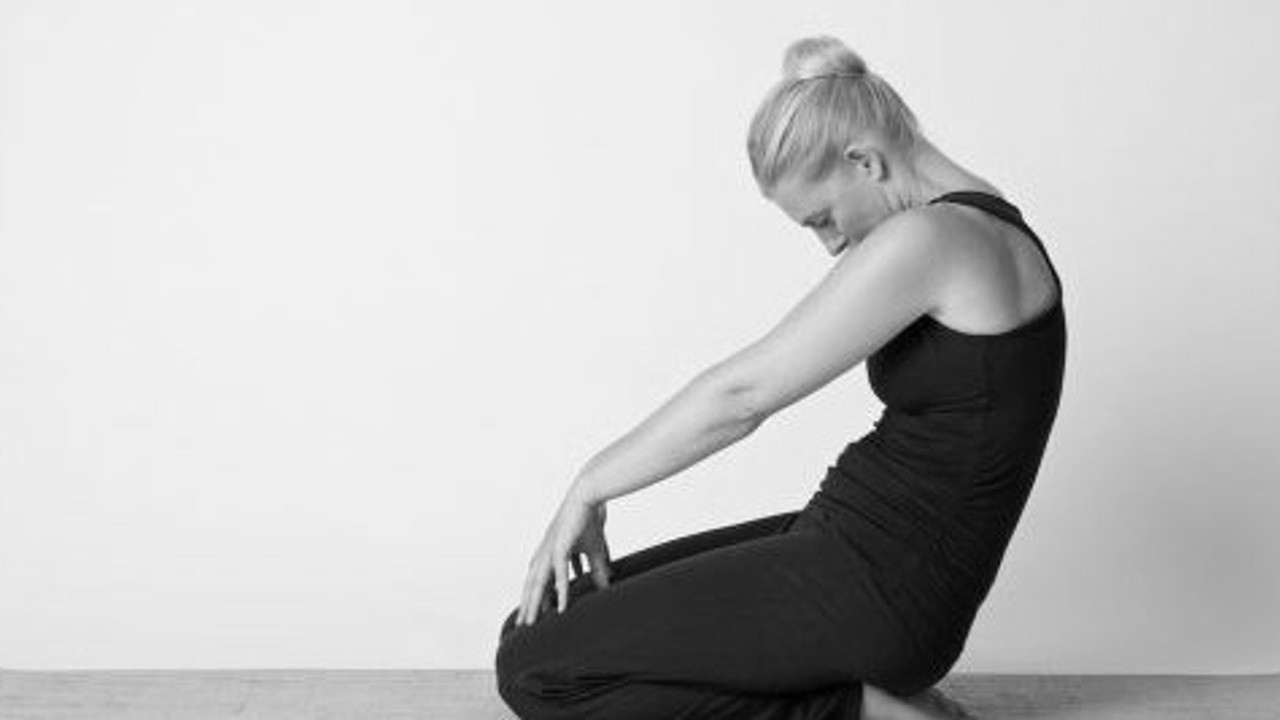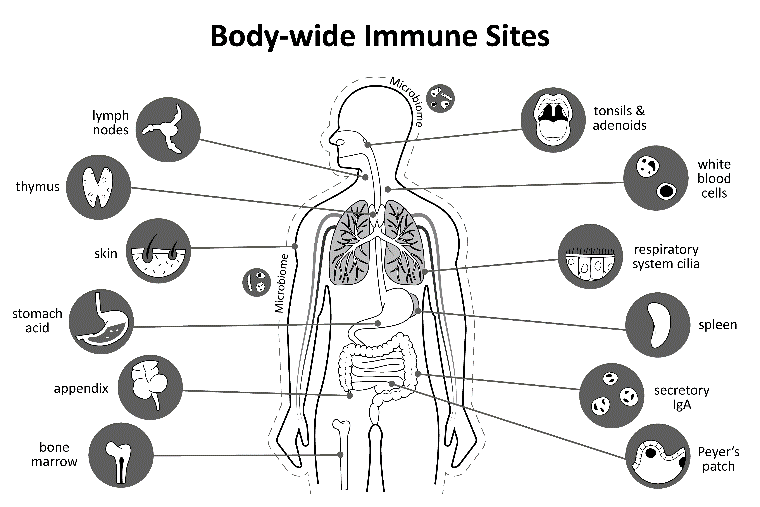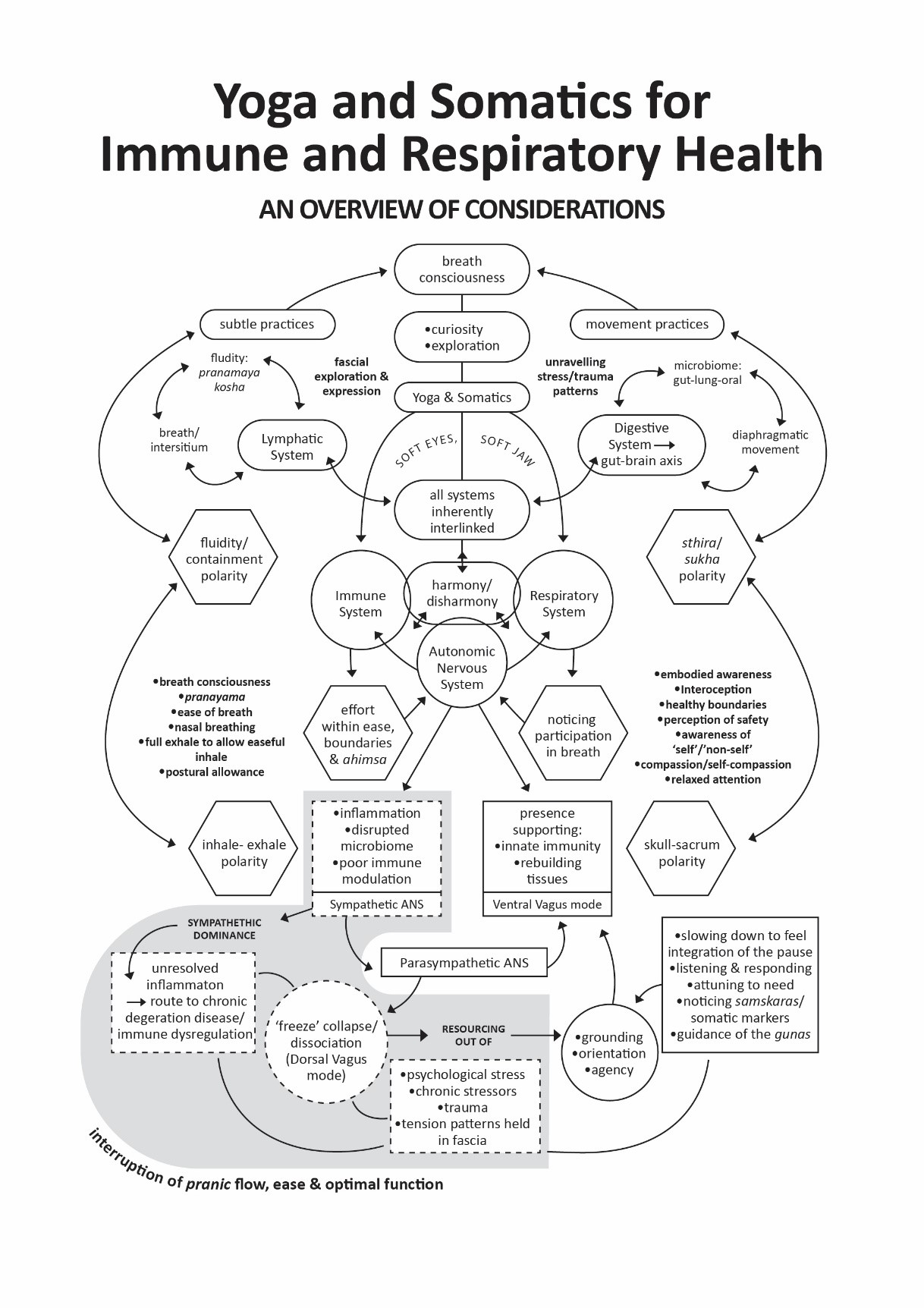Yoga and Somatics for Immune and Respiratory Health – a sneak preview
May 27, 2021
Yoga and Somatics for Immune and Respiratory Health – a sneak preview
After writing my last book Yoga Therapy for Digestive Health, I was already interested in expanding how its elements around the lymphatic system and microbiome linked in with yoga practices and health. This was timed with the first Covid-related lockdown and seemed to flow into a new course on Teaching Yoga for Immune and Respiratory Health. After the fifth round of this course is coming up (June 2021), it seemed a natural progression to follow this content and research into my next book – with the additional ‘Somatics’ in the title above (out early 2022 with Singing Dragon) as that much more accurately described the nature of the physical practice that I teach.
Our bodies and minds have a sublime design, that if we are prepared to listen in, can guide us into what they need moment-to-moment. There are rhythm, pulses and sensations to tune into and connect us to the territory of the immune and respiratory system. These aren’t discreet of course, they are in constant interplay with all aspects of our selves, all of the time.
Immunity is a complex and orchestrated set of processes that are inexorably linked to all other body systems; especially our nervous system and states of energy, being, safety and emotions (all expressed at the heart); including the enteric nervous system (the ‘Second Brain’) within our gut wall and its bacterial colony or microbiome. These extend out to lungs, mouth and skin, all communicating back, and the dance goes on.

The respiratory system includes the upper respiratory tract of the mouth and throat as well as the lungs. The mouth, nose and throat are gateways for immune defence. All of these cavities allow the passage of air and need to be open and responsive, with all of their linings healthy. Well-functioning barriers are healthy places of life that support colonies of bacteria. The mucosal quality of those linings as boundaries is key to the health of the respiratory and immune systems as a whole.
Nasal breathing
This brings us neatly to one of the key aspects of yoga and where we can directly engage with our autonomic nervous system; where we move between calm and active or stressed states.
In the context of yoga, nasal breathing is the means by which prana is balanced (through the ida and pingala nadis); through the direct contact to the brain from the nose. In yoga, the majority of breathing is instructed as nasal; encouraging expansion of the whole respiratory system to support mental and physical vitality. “The nose is for breathing, the mouth is for eating” is said to be a phrase that BKS Iyengar cited often in his teaching.
Nasal breathing has many attributes that support immune and respiratory health. Air is warmed as it comes in through the nose, which opens lung cells more for optimal oxygen absorption. Taking air in through the nose routes it past tiny filtering hairs and mucus linings with immune components that prevent and even destroy impurities entering the body. Cold air coming into the nose cools down the frontal lobe of the brain, which calms its activity, so lowering raised stress levels. Nasal breathing has also shown to increase brain wave coherence – how we organise thoughts, emotions and responses with more ease and adaptability.
Through nasal breathing, we also produce the chemical Nitric Oxide, which opens the cells of the lungs to receive oxygen, supporting bronchial tone by regulating how well the airways in the respiratory tract are able to contract and relax with the breath. This creates homeostasis, a coming into balance that works body-wide, and signals the autonomic nervous system to relax inner muscles of the blood vessels. This increases natural blood flow, allowing dilation where appropriate and lowers blood pressure where it tends to be high, through releasing constrictive in blood vessels. This has a protective effect on the immune system. In balance, Nitric Oxide is an important component within the immune system, controlling and destroying invaders; when in balance with our stress levels and the oxygen to carbon dioxide ratio that is encouraged by nasal breathing[1].
Mouth breathing
According to James Nestor’s research into the breath, we lose 40 percent more water at night by mouth breathing, also losing our first defence against oral bacteria. Mouth breathing and the resultant drying out of mucosal linings in the airways can lead to oral hygiene problems as well as long-term systemic issues such as asthma, snoring and sleep apnoea, and gastrointestinal disorders[2]. When we don’t sleep deeply because we are disrupted by our own breathing patterns, hormones are unbalanced, we don’t receive enough oxygen to the brain, so even growth and intelligence can be affected as well as our energy levels in general, leading to associated issues such as, “attention deficit disorder (ADHD), diabetes, high blood pressure, cancer and so on…”[3].
Shifting to nasal breathing
Patiently retraining our samskaras, or habits, through pranayama practises, conscious breathing, we can, over time, help to overcome patterned mouth breathing. This isn’t simply expecting this shift to suddenly happen, although bringing consciousness to a habit can certainly start the process of change. As much of the route to habitual mouth breathing is postural, a coaxing and unravelling of ingrained muculo-skeletal and fascial shifts from our most comfortable design can take a little time. Patterns are often with head shunted forward of the mid-line to ‘gasp’ for breath through the mouth as the chest is collapsed.
In the book and in the practices within the course, we explore yoga and somatic practices that help to repattern fascia and muscle that have become stuck in postural habits that encourage mouth breathing.
The whole picture
Nasal breathing is part of a whole-body picture that allows us to orchestrate the defences of our immunity and the nourishment of our respiration. For the book, I have put together the diagram below to help readers navigate the threads that we can access and meet with the wonderful array of physical and subtle practices in the yoga canon.

Find further details on Charlotte’s online course with Yogacampus, Teaching Yoga for Immune and Respiratory Health here.
[1] Chron Respir Dis. 2009; 6(1): 19–29
[2] Flutter, J. (2006). The negative effect of mouth breathing on the body and development of the child. Int. J. Orthod. Milwaukee 17, 31–37
[3] Breath: The New Science of a Lost Art. Nestor, James, Penguin Life, 2020




